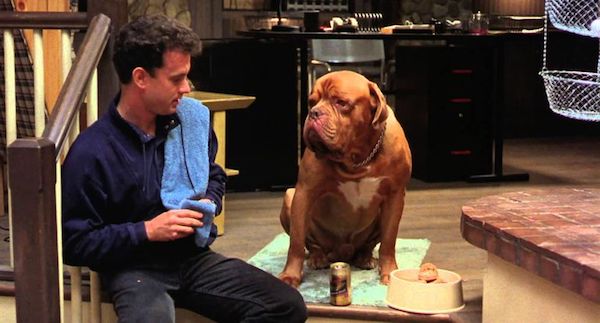
In time, Tom Hanks would say that the 1989 movie, Turner and Hooch, was “exhausting” to make. During an interview with Larry Kind in 2001, Hanks said that filming Turner & Hooch was the hardest work he ever had to do, physically and emotionally, and specifically brought up the movie’s stakeout scene. “I’m staking out a scene of a crime with my dog Hooch … We had a car on the set that was surrounded by bungee-cams, literally cameras that were hanging from bungee-cords. And the whole thing was about, whatever this dog does, I react to. We will not ask the dog to do anything specifically, this dog will just do things … And I will react. That was the hardest I’ve ever worked.”
Of his co-star, Hanks said “I learned a lot from that dog,” but from our perspective, it was an important comedy for having exposed the public to the Dogue de Bordeaux. In what some thought was a dark tone for a Disney movie, the plot centered on neatnik police investigator (Tom Hanks) whose only witness to a murder is “Hooch,” a rambunctious Dogue de Bordeaux. At its core, the movie is about two wildly divergent personalities opening their hearts to one another through mutual understanding, something dog owners have always known about having a dog.
A Dogue de Bordeaux was not initially the first breed that came to mind. Fifty different breeds, from Rottweilers to Airedales, were considered. It had to be big, but not too big. In the end, filmmakers settled on the Dogue de Bordeaux, but in 1989, there were less than 300 of the breed in America.
Born in 1978, the Dogue who played “Hooch” was “Beasley” bred by Peter Curley from TNT Kennels in Wisconsin, the first American to import the breed into the United States. One source says that Curley imported and sold four Dogues to Disney: “Barry,” Beasley,””Vigor,” and “Cristo” to Disney, but Beasley would come to be owned by the same man who trained him for the film, Clint Rowe, who also made a brief appearance in the film as an ASPCA officer. Rowe was initially hired by the film to serve as a consultant for the dog selection process, but in the end, they used his own dog.

Rowe was hardly a rookie. He was previously best known for his work with “Mike,” the Dog in the movie, “Down and Out in Beverly Hills” and “Jed,” the dog in “The Adventures of Natty Gann.”
Barry and Vigor were also part of the movie team and were recruited to be Beasley’s double, or “stuntdog.” Rowe had taught all the “Hooches” to look at the person making a clicker sound. Before every take, Tom Hanks would be given a little clicker he would use to “click.” The dog would look at him, and until the clicker was handed back, the only person the dog was interested in was Tom Hanks.
